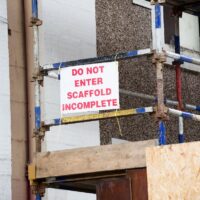Legal Implications of Falls From Heights on Construction Sites Beyond Scaffold Law

Falls from heights are among the leading causes of serious injury and death on construction sites in New York and across the country. While New York’s Labor Law Section 240, commonly known as the “Scaffold Law,” provides strong protections for workers injured in gravity-related accidents, there are often additional legal implications worth considering. Understanding these broader legal principles is key to ensuring injured workers receive full and fair compensation, particularly for falls that occur during activities not covered by the Scaffold Law. Learn more below, and contact Dupée & Monroe, P.C., to speak with an experienced and dedicated Goshen construction accident lawyer helping injury victims throughout Orange County and the mid-Hudson Valley.
The Scaffold Law: A Powerful but Specific Tool
Labor Law Section 240 holds property owners, general contractors, and certain agents strictly liable for injuries caused by falls from scaffolds, ladders, and other elevation-related hazards when proper safety devices are not provided. This law is unique to New York and has been instrumental in protecting workers from the consequences of inadequate fall protection.
However, not every fall from a height qualifies for a Scaffold Law claim. The statute generally applies only to specific types of work, such as construction, demolition, repair, or alterations to buildings and structures. It also requires a demonstrated failure to provide necessary safety equipment. If these conditions are not met, injured workers may need to look beyond Section 240 to seek justice.
Liability Under Labor Law Sections 200 and 241(6)
Even if Section 240 does not apply, other provisions of New York’s Labor Law can provide a pathway to compensation. Section 200 is a general safety statute that requires owners and contractors to maintain a safe work environment. It can support a negligence claim if an employer or property owner failed to address a known hazard that contributed to the fall.
In addition, Section 241(6) imposes a duty on contractors and owners to comply with specific regulations set forth in the New York Industrial Code. These regulations cover a wide range of construction activities and often include detailed provisions related to fall protection, safety harnesses, and working surfaces. Proving a violation of one of these regulations that leads to a fall may be used to establish liability.
Third-Party Liability Beyond Labor Law
In many construction site falls, parties other than the employer or property owner may be partly or wholly responsible. For instance, a subcontractor may have failed to follow proper safety protocols, or a manufacturer may have provided a defective ladder or harness. In these situations, injured workers may be able to file a third-party personal injury lawsuit, in addition to a workers’ compensation claim.
These third-party claims are critical because workers’ compensation benefits alone often fall short of covering the full impact of a serious injury. A personal injury lawsuit allows the injured worker to seek compensation for pain and suffering, future lost income, diminished quality of life, and other non-economic damages.
The Role of OSHA and Industry Standards
Although OSHA (Occupational Safety and Health Administration) regulations do not create a private right of action, they can serve as valuable evidence in establishing negligence. If a contractor or employer violated OSHA fall protection standards and that violation contributed to a fall, it can support a claim under Labor Law Section 200 or a third-party negligence theory.
Additionally, industry best practices—such as routine safety inspections, mandatory fall protection training, and use of guardrails or personal fall arrest systems—can further bolster a case. Demonstrating that a defendant failed to meet well-established safety standards can be persuasive in court.
Why Legal Representation Matters
Cases involving falls from heights are rarely straightforward. They often involve multiple parties, overlapping statutes, and competing insurance interests. Proving liability requires a detailed investigation into the accident scene, equipment used, witness statements, and applicable safety regulations. This is not something an injured worker should have to deal with alone.
At Dupée & Monroe, P.C., we have years of experience representing construction workers injured in falls throughout Orange County and the Hudson Valley. We understand how to apply and extend New York labor laws, identify liable parties beyond the employer, and maximize compensation through civil claims.
Get the Legal Help You Deserve After a Fall at a NY Construction Site
If you or a loved one has suffered a fall from a ladder, scaffold, roof, or other elevated surface on a New York construction site, you may have more legal options than you realize. The Scaffold Law is a powerful tool, but it’s not the only one. Let the experienced attorneys at Dupée & Monroe, P.C. evaluate your case, explain your rights, and help you pursue every available avenue for recovery. Contact us today for a free consultation.
